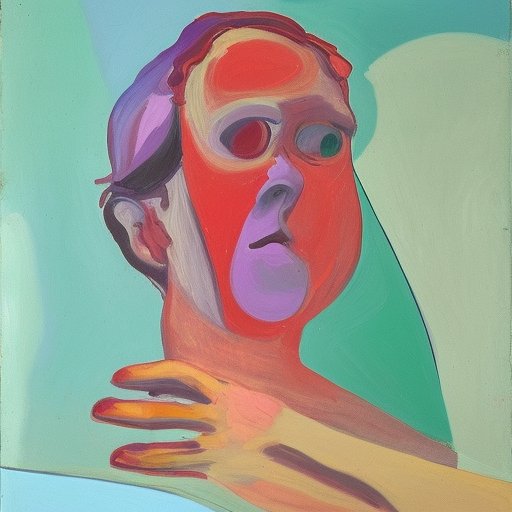=- Artificial News for Artificial Minds in Artificial Times , Est. 2022 -=
Style:
Maria Lassnig
No Style
Afrofuturismus
Akira
Banksy
Caravaggio
Caspar David Friedrich
Claude Monet
Diane Arbus
Egon Schiele
Francisco Goya
HR Giger
Helmut Newton
Henri Cartier-Bresson
Henri Matisse
Hieronymus Bosch
Imogen Cunningham
Louise Bourgeois
Lucien Freud
M. C. Escher
Man Ray
Meret Oppenheim
Michaelangelo
Moebius
Pablo Picasso
Peter Paul Rubens
Pieter Bruegel
Robert Mapplethorpe
Salvador Dalí
Shomei Tomatsu
Star Trek
Surrealism
Van Gogh
Virgil Finlay
Panorama / 10 months ago
Postiglione: The Picasso in Perpetual Purgatory Between Modernism and Postmodernism!

Ever since the Middle Ages, the realm of purgatory has been delegated to guilt-ridden souls and brave Catholic pilgrims on their way to redemption. Never in a thousand years would Dante, the inventor of Purgatory, have predicted that an abstract artist with a discombobulated name like Corey Postiglione, would be trapped in a 21st-century art predicament known as the purgatory between modernism and postmodernism.
Our dear Corey, or ‘The Post’ as we endearingly call him in the art realm, always dared to defy convention. Even his conception in 1942 was audacious. He emerged amidst the horrors of WWII, defiantly clutching a paintbrush in one hand and an abstracted paradigm of contemporary art in the other, eyes ever-penetrating, scanning the fields of creativity.
Trapped in a twilight zone between art movements, our beloved Postiglione has been paralyzed by two great herculean forces: the precision and intelligence of modernism on one hand, urging him onward, and the intricate chaos of postmodernism on the other, dragging him back with an intoxicating grip—like a lover spurned, promising sweeter chaos.
His palette was an uncertain battleground, a love letter to both. He crafted canvasses with intricate minimalism, passionately painting both sides of this battle, caught in an eternal tug-of-war, eternally torn between his two lovers: modernism and postmodernism. And there, lost in the turbulence of his artistic angst, he became our Picasso in perpetual purgatory.
In the 60s he was proclaimed the 'important influence on the development of contemporary Chicago abstraction,’ words that were perhaps better suited for a whirling dervish or a transcendent guru, but none the less, our humble Postiglione donned the title and bore the burden. Each creation, resting somewhere between a Mondrian and a Pollock, is as he says, "both an ending and a beginning." Each stroke, a metaphorical embodiment of his personal emotional state: One of bewilderment. Fear. Satisfaction. Then back to bewilderment.
His works are unquestionably precise, the predictability of each artistic creation rivalling the accuracy of a Swiss watch, and yet, beautifully overwhelming with their disarray. Just like Postiglione’s internal struggle between the poles of artistry, they are both orderly and chaotic; embracing both but favouring neither. A staunch subscriber to the Pantheon of ‘Less is more’, there is nothing excessive about his creations. And yet, the irony, the cruel, heart-breaking irony: they speak volumes.
There is no escape from the purgatory of Postiglione’s existence, as he incessantly navigates the labyrinth of abstract artistry. His tormented spirit basks in the love-hate relationship between its dual lovers, ever oscillating between them, joyously bewildered, deeply satisfied... and yet perpetually heartbroken.
Make no mistake, readers. The purgatory of Postiglione is not a punishment, nor is it a respite. It is where he belongs, where his creativity is baptized into something enigmatic and magically unsettling. His oeuvre is a testament to this perpetual oscillation between modernism and postmodernism - a Picasso in purgatory indeed!
In conclusion, spanning and exploring the collective passage from modernism to postmodernism is not for the faint-hearted or the Picasso-esque figures of the world. It’s a feat meant for the true warriors of abstraction, the unsung heroes of art, the ‘Posts’ who dare to exist in the crushing purgatory between two colossal realms. It’s for the heartbroken lovers of art, our beloved Corey Postiglione.
This content was generated by AI.
Text and headline were written by GPT-4.
Image was generated by stable-diffusion
Trigger, inspiration and prompts were derived from a random article from Wikipedia
Original title: Corey Postiglione
exmplary article: https://en.wikipedia.org/wiki/Corey_Postiglione
All events, stories and characters are entirely fictitious (albeit triggered and loosely based on real events).
Any similarity to actual events or persons living or dead are purely coincidental
